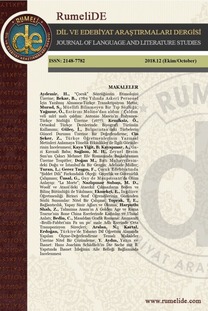Çeviri Yaparken Cinas ve Çarpık Deyimlerle Nasıl Başa Çıkabiliriz?
Cinaslar, söz oyunları, çarpık deyimler, çeviri
Puns and Idiom-Based Wordplays – How to Deal With Them in Translation?
Puns, idiom-based wordplay, play on words, translation,
___
- Alexieva, B. (1997). There Must Be Some System in this Madness. In D. Delabastida (éd.) Traductio. Essays on Punning and Translation. Manchester, England and Namur, Belgium: St Jerome Publishing and Presses Universitaires de Namur, 136-154.
- Capra, A. (2010). Traduttore traditore: de la possibilité de traduire les expressions figées en littérature Textes & contextes, 5 « Stéréotypes en langue et en discours ». Retrieved from http://revuesshs.u-bourgogne.fr/textes&contextes/sommaire.php?id=940
- Delabastida, D. (1996). Introduction. The Translator 2 (2) Special issue on Wordplay and Translation, 127-139.
- Delbastida, D. (2004). Literary style in translation: wordplay. In Kittel H., Frank, A. P., Greiner, N., Hermans, T., Koller, W., Lambert, J. & Paul, F. (eds) Uberzetzung/ Tranlation/Traduction, Encyclopédie internationale de la recherché sur la traduction. Tome 1, Berlin, Germany and New York, USA : Walter de Gruyter. 870-874. Retrieved from https://www.academia.edu/4406973/Literary_style_in_translation_wordplay.
- Dimova, A. (2000). Увод в теорията на превода. Шумен, България: Университетско издателство „Епископ Константин Преславски“.
- Eco, U. (2003). Dire presque la même chose. (trad. de l’italien). Paris, France : Bernard Grasset.
- Florin, S. (1983). Муки переводческие [Souffrances du traducteur]. Москва, Русия : Высшая школа.
- Gentzler, Е. (1999). Съвременни теории на превода [Contemporary Translation Theories trad. bulg.], В. Търново, България : Пик.
- Henry, J. (2003). La traduction des jeux de mots. Paris : Presses Sorbonne Nouvelle.
- Kerbrat-Orecchioni, C. (1977). La connotation. Lyon, France : Presses universitaires de Lyon.
- Kerbrat-Orecchioni, C. (1986). L’implicite. Paris, France : Armand Colin.
- Nida E. & Taber, Ch. (1982 [1969]). The Theory and Practice of Translation. Leiden, The Netherlands: Published for the United Bible Societies by E. J. Brill.
- Snell-Hornby, M. (1995 [1987]). Translation studies. An integrated approach. Amsterdam, The Netherlands: John Benjamins Publishing Company.
- Stöl, L. (1971) Traduisibilité et intraduisibilité. Meta, 16 (1-2), 25-31. Retrieved from http://id.erudit.org/iderudit/004199ar
- Shveitzer, A. D. (1988). Теория перевода [Théorie de la traduction]. Наука, Москва, 1988.
- Veisbergs, A. (1997). The Contextual Use of Idiom, Wordplay and Translation. In D. Delabastida (Ed.). Traductio. Essays on Punning and Translation. Manchester, England and Namur, Belgium: St Jerome Publihing, Presses Universitaires de Namur, 155-176.
- Villers, D. (2010). Les modalités du détournement proverbial: entre contraintes et libertés. Modèles linguistiques [En ligne], 62/2010. Retrieved from URL: http://ml.revues.org/237
- Vlakhov S. & Florin, S. (1990). Непреводимото в превода [L’intraduisible en traduction]. София, България: Наука и изкуство.
- Walkiewicz, B. (2001) Comment traduire le comique verbal. Studia Romanica Posnanensia, XXVII, Posnań, Poland: Adam Mickiewicz University Press, 173-185. Retrieved from
- https://repozytorium.amu.edu.pl/jspui/bitstream/10593/6025/1/18_Barbara_Walkiewicz_Comment%20traduire%20le%20comique%20verbal_173-185.pdf
- ISSN: 2148-7782
- Yayın Aralığı: 6
- Başlangıç: 2014
- Yayıncı: Yakup YILMAZ
Seyahat Rehberlerinde Kültüre Özgü Ögelerin Aktarımı: İzmir Örneği
The Double Passage: Köle Anlatısında Sesin İcrası
Spor Tercümanlığı ve İltimas: Manipülatörler ya da Günah Keçileri
Bilimi Halka Yayma Söyleminin Çevirisi: Çekicilik ve Bilimsellik
Çevirmenin Kültürlerarası Yetkinliğinin Teşviki
Halk Kullanımına Geçmiş Sözlüksel Öğelerin Çevirisi
Çeviri Yaparken Cinas ve Çarpık Deyimlerle Nasıl Başa Çıkabiliriz?
Profesyonel Çevirmenlerin Değerlendirilmesinde Mantık Kısıtlarının Önemi
